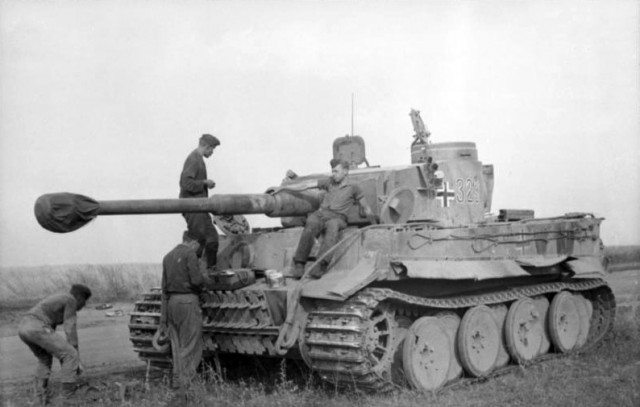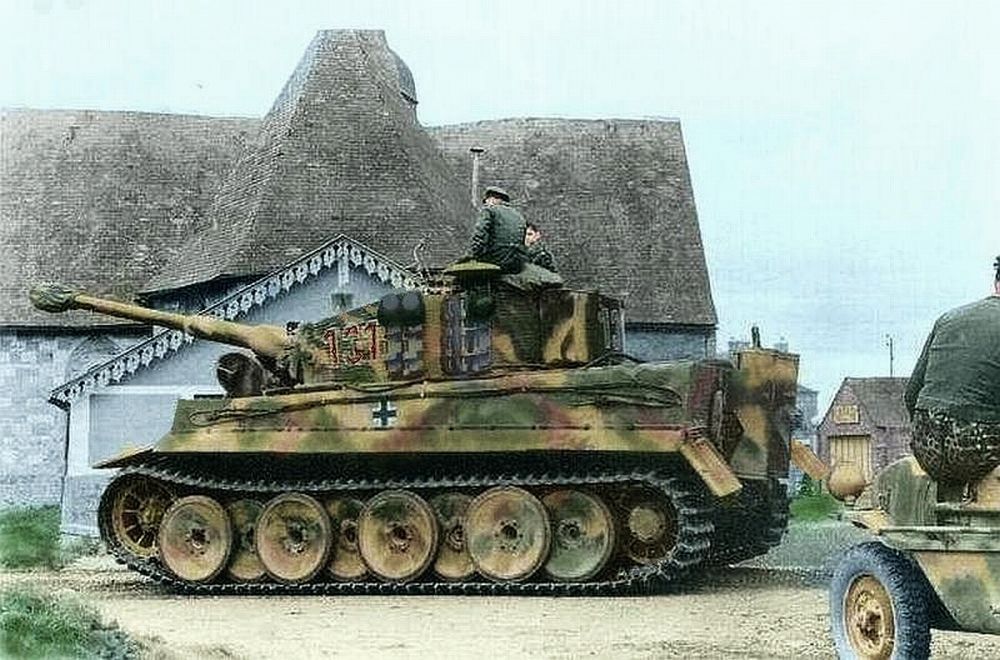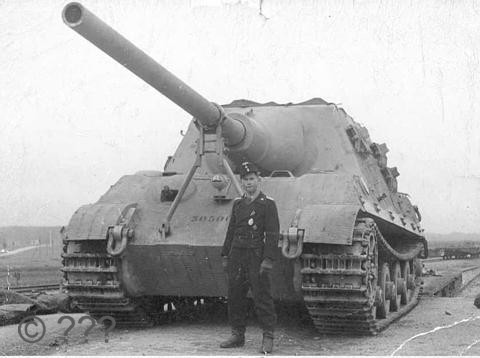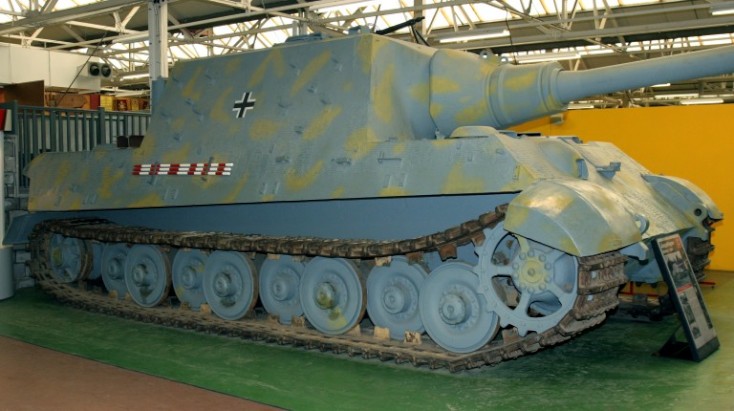PERO QUE ERAN LOS MAS BELLOS TANQUES ES INEGABLE ME 109los tres gigantes nazis tuvieron ese problema
Estás usando un navegador obsoleto. No se pueden mostrar estos u otros sitios web correctamente.
Se debe actualizar o usar un navegador alternativo.
Se debe actualizar o usar un navegador alternativo.
Tigres y Tigres Reales
- Tema iniciado Nocturno Culto
- Fecha de inicio
M
Me 109
PERO QUE ERAN LOS MAS BELLOS TANQUES ES INEGABLE ME 109
Concuerdo con el Panther y el Tigre II; el I...muy agraciado no lo veo.-
@Shandor tal vez deberías corregir el titulo: ya que el tanque Tiger II (Tigre II) oficialmente Panzerkampfwagen Tiger Ausf. B también se conoció con el nombre informal "Königstiger" (el nombre alemán para "Tigre de Bengala"), a menudo mal traducido literalmente como King Tiger (Rey Tigre) o Royal Tiger (Tigre Real) por los soldados aliados...por lo que el titulo correcto del thread seria: Fotos de los Tigres y Tigres de Bengala
El bicho -de cuatro patas, sin orugas- se llama oficialmente panthera tigris tigris. En diferentes idiomas puede ser llamado como se quiera (justamente por eso el nombre científico va en latín, para saber a que se refieren). En español, se usa indistintamente tigre real o tigre de bengala, pero en alemán es konig (rey, real) tiger = tigre real.
Hermosos bichos, pero de cristal.-
Yo matizaría eso. Es verdad que tuvieron problemas, pero consideremos que eran vehículos nuevos, introducidos a toda prisa en tiempo de guerra. Y el resultado no fue catastrófico. No eran un Sherman o T-34 (de los bien fabricados), pero si algo comparable a los modelos británicos por ejemplo, e incluso, mejor que algunos de estos.
No son fotos pero:
Königstiger {m}; Bengaltiger {m}; Indischer Tiger [zool.] Bengal tiger; Royal Bengal tigerEl bicho -de cuatro patas, sin orugas- se llama oficialmente panthera tigris tigris. En diferentes idiomas puede ser llamado como se quiera (justamente por eso el nombre científico va en latín, para saber a que se refieren). En español, se usa indistintamente tigre real o tigre de bengala, pero en alemán es konig (rey, real) tiger = tigre real.

Tiger`s reputation may be in need of a rewrite
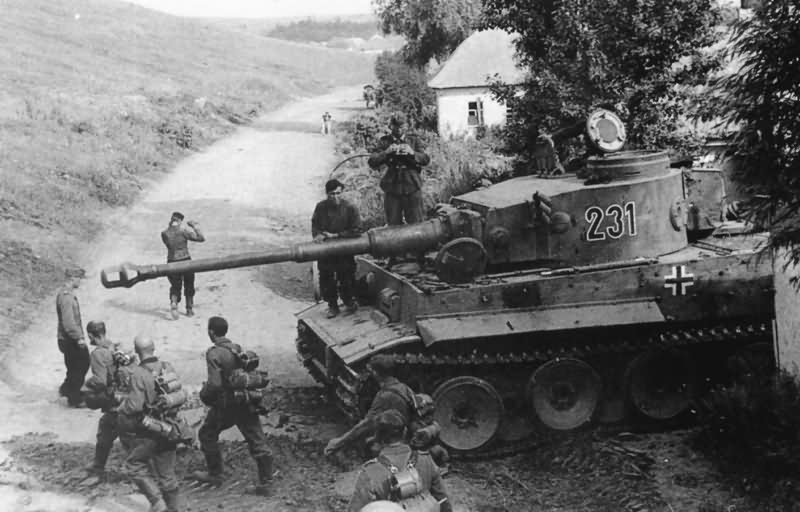
“To a New Yorker like you, a hero is a weird type of sandwich, not some nut who takes on three Tigers.” The line is from the 1970 Second World War comedy Kelly’s Heroes: Donald Sutherland’s early-hippie tank commander Oddball had grave misgivings about pitting his American Sherman against a trio of feared German Tiger tanks.
Brad Pitt’s murderous Wardaddy character faces a similar, though decidedly bloodier dilemma in the newly released movie Fury when his squad of four Shermans faces off against a “goddamn Tiger” deep inside Germany late in the war. As the introduction grimly informs us: “U.S. tank crewmen suffered staggering losses” when up against superior German tanks such as the Tiger. A hulking Tiger is also one of the last things Capt. John Miller, played by Tom Hanks, sees before dying in Saving Private Ryan .
Whenever Hollywood shifts its attention to Second World War tank combat, the German Panzerkampfwagen VI, aka the Tiger, inevitably lumbers into view, more often than not pitted against the thinly-armoured though heroically-crewed Sherman tanks that were a mainstay of the American, British and Canadian armies. It’s a classic David and Goliath match-up, but with armour-piercing shells in place of rocks and foreheads.
“The experience of GIs in Europe has created this mythology of the invincible Tiger tank,” observes Steven J. Zaloga, author of dozens of books on tank combat and strategy. “The Tiger has become part of public consciousness.” Notable for its authentic tank scenes, Fury features the first movie appearance of the only Tiger still in working condition, on loan from the Tank Museum, Bovington in England. Yet as with most of what Hollywood peddles, the Tiger’s reputation may be in need of a rewrite. Despite the compelling image of an impregnable tank crawling across the battlefield with enemy shells bouncing off like pebbles, the actual record of tank combat from the Second World War reveals size and excellence in tank design often has little to do with success. Like location in the real estate market, the top three secrets to winning tank battles are quantity, quantity, quantity. With rare exceptions, it’s not the better tank that wins. Rather, the winning tank is the one that has another hundred just like it right behind writes nationalpost.com
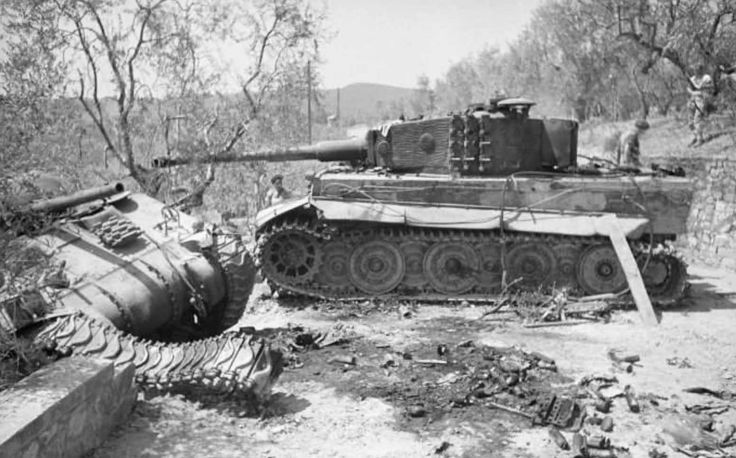
“The fact of the matter is American soldiers hardly ever met a Tiger,” says Zaloga, “They tended to identify any German tank they met as a Tiger simply on the basis of reputation alone.” His own research reveals just three incidents during 1944 and 1945 when U.S. tankers came face-to-face with a Tiger, including once when a group of the fearsome tanks was lamely strapped to a railway flatcar and destroyed without much effort.
The Tiger was notoriously expensive and time-consuming to build, gobbling up resources the German war economy could ill afford. And it was a mechanical nightmare. Due to their intricate design and size, early models of the Tiger and Panther, another German tank with an out sized reputation, had low reliability rates. Combining cost factors with usability rates, it would’ve been possible for Hitler’s Germany to field six garden-variety tanks for every one Tiger. “The Germans’ tank designs were always on the bleeding edge,” says Zaloga. “But they were too expensive, too complex and there was never enough spare parts.”
In one famous encounter in June 1944, a Tiger commanded by Capt. Michael Wittman laid waste to two dozen British tanks and other armoured vehicles in a single afternoon at Villers-Bocage
In the right conditions, of course, the Tiger was a formidable presence. Unlike American GIs who claimed to see Tigers behind every hedgerow in Normandy, Canadian and British tankers regularly squared up with them in the campaigns following D-Day. In one famous encounter in June 1944, a Tiger commanded by Capt. Michael Wittman laid waste to two dozen British tanks and other armoured vehicles in a single afternoon at Villers-Bocage.
CorreoMás...
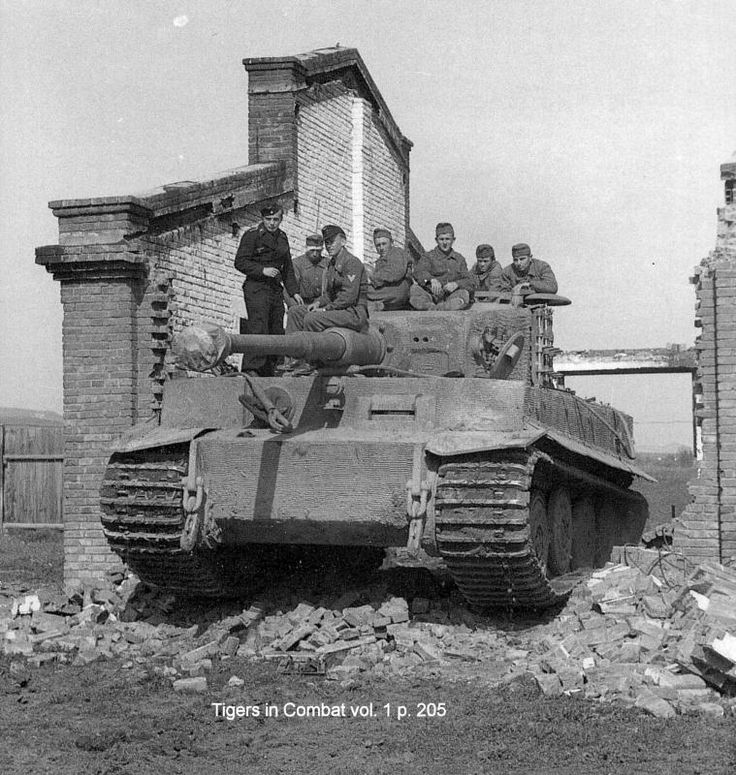
“One shot from a Tiger could disable a Sherman, while a single Sherman had very little chance of destroying a Tiger,” says Terry Copp, professor emeritus of history at Wilfrid Laurier University and former director of the Laurier Centre for Military, Strategic and Disarmament Studies. “So the Canadians learned to use their armour in different ways.” The main tactic being to rely on volume and maneuverability
In comparison to small numbers of highly-engineered German Panzers, Allied forces opted for standardization and mass production. The obvious defects of the Sherman — a thin skin and small gun — were ignored in an effort to overwhelm Nazi Europe with tens of thousands of cheap, fast tanks. The Sherman had a high reliability rate, and they were available in a near-limitless supply.
According to Copp, it wasn’t unusual for a Canadian tank crew to have a Sherman shot out from under them, make their way back to friendly territory, hop in a new tank and return to the battlefield. The Elgin Regiment of St. Thomas, Ont. served as Canada’s tank delivery service during the war, its only job being to drive fresh Shermans to the front.
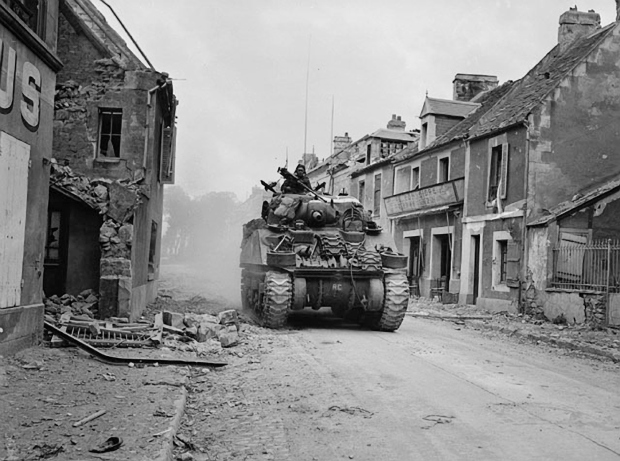
A Sherman tank from the Sherbrooke Fusiliers advancing in Caen on July 10, 1944.
The Sherman design was also flexible enough to accept numerous upgrades. Within every Canadian tank troop of four Shermans, one was the “Firefly” model equipped with a longer 17-pounder gun that could go toe-to-toe with a Tiger’s 88. Capt. Wittman, with 143 tank kills to his name and thus the greatest tank ace in history, was finally taken out in August 1944 by a British Firefly, although Canadian historian Brian Reid has mustered a Warren Commission-style argument that the kill shot must have come from a Firefly of Canada’s Sherbrooke Fusiliers.
By April 1945 — when Fury takes place — Zaloga calculates the American army had 11,000 Shermans at their disposal, and the British and Canadians another three or four thousand. The German army facing them had perhaps one hundred working tanks.
“The Sherman was a purely mediocre design,” he says. “Sure the Germans had better tanks, but who triumphs in the end?”
Despite its outsized reputation, the Tiger was never available in sufficient quantities to be a difference-maker in western Europe. The same lesson played out on the Eastern Front as well

“To a New Yorker like you, a hero is a weird type of sandwich, not some nut who takes on three Tigers.” The line is from the 1970 Second World War comedy Kelly’s Heroes: Donald Sutherland’s early-hippie tank commander Oddball had grave misgivings about pitting his American Sherman against a trio of feared German Tiger tanks.
Brad Pitt’s murderous Wardaddy character faces a similar, though decidedly bloodier dilemma in the newly released movie Fury when his squad of four Shermans faces off against a “goddamn Tiger” deep inside Germany late in the war. As the introduction grimly informs us: “U.S. tank crewmen suffered staggering losses” when up against superior German tanks such as the Tiger. A hulking Tiger is also one of the last things Capt. John Miller, played by Tom Hanks, sees before dying in Saving Private Ryan .
Whenever Hollywood shifts its attention to Second World War tank combat, the German Panzerkampfwagen VI, aka the Tiger, inevitably lumbers into view, more often than not pitted against the thinly-armoured though heroically-crewed Sherman tanks that were a mainstay of the American, British and Canadian armies. It’s a classic David and Goliath match-up, but with armour-piercing shells in place of rocks and foreheads.
“The experience of GIs in Europe has created this mythology of the invincible Tiger tank,” observes Steven J. Zaloga, author of dozens of books on tank combat and strategy. “The Tiger has become part of public consciousness.” Notable for its authentic tank scenes, Fury features the first movie appearance of the only Tiger still in working condition, on loan from the Tank Museum, Bovington in England. Yet as with most of what Hollywood peddles, the Tiger’s reputation may be in need of a rewrite. Despite the compelling image of an impregnable tank crawling across the battlefield with enemy shells bouncing off like pebbles, the actual record of tank combat from the Second World War reveals size and excellence in tank design often has little to do with success. Like location in the real estate market, the top three secrets to winning tank battles are quantity, quantity, quantity. With rare exceptions, it’s not the better tank that wins. Rather, the winning tank is the one that has another hundred just like it right behind writes nationalpost.com

“The fact of the matter is American soldiers hardly ever met a Tiger,” says Zaloga, “They tended to identify any German tank they met as a Tiger simply on the basis of reputation alone.” His own research reveals just three incidents during 1944 and 1945 when U.S. tankers came face-to-face with a Tiger, including once when a group of the fearsome tanks was lamely strapped to a railway flatcar and destroyed without much effort.
The Tiger was notoriously expensive and time-consuming to build, gobbling up resources the German war economy could ill afford. And it was a mechanical nightmare. Due to their intricate design and size, early models of the Tiger and Panther, another German tank with an out sized reputation, had low reliability rates. Combining cost factors with usability rates, it would’ve been possible for Hitler’s Germany to field six garden-variety tanks for every one Tiger. “The Germans’ tank designs were always on the bleeding edge,” says Zaloga. “But they were too expensive, too complex and there was never enough spare parts.”
In one famous encounter in June 1944, a Tiger commanded by Capt. Michael Wittman laid waste to two dozen British tanks and other armoured vehicles in a single afternoon at Villers-Bocage
In the right conditions, of course, the Tiger was a formidable presence. Unlike American GIs who claimed to see Tigers behind every hedgerow in Normandy, Canadian and British tankers regularly squared up with them in the campaigns following D-Day. In one famous encounter in June 1944, a Tiger commanded by Capt. Michael Wittman laid waste to two dozen British tanks and other armoured vehicles in a single afternoon at Villers-Bocage.
CorreoMás...

“One shot from a Tiger could disable a Sherman, while a single Sherman had very little chance of destroying a Tiger,” says Terry Copp, professor emeritus of history at Wilfrid Laurier University and former director of the Laurier Centre for Military, Strategic and Disarmament Studies. “So the Canadians learned to use their armour in different ways.” The main tactic being to rely on volume and maneuverability
In comparison to small numbers of highly-engineered German Panzers, Allied forces opted for standardization and mass production. The obvious defects of the Sherman — a thin skin and small gun — were ignored in an effort to overwhelm Nazi Europe with tens of thousands of cheap, fast tanks. The Sherman had a high reliability rate, and they were available in a near-limitless supply.
According to Copp, it wasn’t unusual for a Canadian tank crew to have a Sherman shot out from under them, make their way back to friendly territory, hop in a new tank and return to the battlefield. The Elgin Regiment of St. Thomas, Ont. served as Canada’s tank delivery service during the war, its only job being to drive fresh Shermans to the front.
A Sherman tank from the Sherbrooke Fusiliers advancing in Caen on July 10, 1944.
The Sherman design was also flexible enough to accept numerous upgrades. Within every Canadian tank troop of four Shermans, one was the “Firefly” model equipped with a longer 17-pounder gun that could go toe-to-toe with a Tiger’s 88. Capt. Wittman, with 143 tank kills to his name and thus the greatest tank ace in history, was finally taken out in August 1944 by a British Firefly, although Canadian historian Brian Reid has mustered a Warren Commission-style argument that the kill shot must have come from a Firefly of Canada’s Sherbrooke Fusiliers.
By April 1945 — when Fury takes place — Zaloga calculates the American army had 11,000 Shermans at their disposal, and the British and Canadians another three or four thousand. The German army facing them had perhaps one hundred working tanks.
“The Sherman was a purely mediocre design,” he says. “Sure the Germans had better tanks, but who triumphs in the end?”
Despite its outsized reputation, the Tiger was never available in sufficient quantities to be a difference-maker in western Europe. The same lesson played out on the Eastern Front as well
Se que el tópic es de fotos, pero no puedo resistirme a algunos comentarios. Busqué un lugar más apropiado pero no hallé ningún tema sobre el Tigre o en general de tanques en la SGM. Tal vez estaría bueno abrir alguno.
Algunas estadísticas sirven un poco para mejorar la vista de la situación. El US Army's Ballistics Research Lab (los saqué del Osprey "Panther VS Sherman en la Batalla del Bulge") llevó a cabo una búsqueda de datos de luchas tanque VS tanque en Europa. Tomó dos unidades, la 3° y 4° Divisiones acorazadas, puesto que eran las que habían visto más luchas de ese tipo; un total de 98 combates tanque VS tanque, desde agosto a fines de diciembre de 1944, incluyendo 33 combates en la Batalla de las Ardenas.
Puntos importantes:
1-El típico combate tanque VS tanque, en contra de lo imaginado popularmente, involucraba usualmente unidades muy pequeñas (pelotones); nueve tanques estadounidenses contra cuatro alemanes fue el promedio. Menos de un tercio de los combates involucró más de tres blindados alemanes.
2-La distancia promedio a la cual los tanques estadounidenses destruyeron panzers fue de 893 yardas (816,5 metros); la distancia promedio a la cual los blindados alemanes destruyeron blindados estadounidenses fue de 946 yardas (865 metros).
3-El factor individual más importante era cual bando divisiba primero al enemigo, y le disparaba primero. Ergo, el bando defensor tenía la ventaja de su lado, dado que normalmente se encontraba emboscado, en una buqna posición de tiro. En los casos estudiados, los defensores dispararon primero el 84% de las veces.
4-Los combates son cortos y rápidos; el bando que primero divisa al enemigo lo inunda con una lluvia de fuego de todos sus blindados en el primer minuto.
5-Hubo 29 enfrentamientos Sherman VS Panther. Los Sherman tenían ventaja numérica de 1,2 a 1. Los datos sugieren que el Panther era 1,1 veces más efectivo que el Sherman cuando peleaba a la defensiva, mientras que el Sherman, a la defensiva era 8,4 veces más efectivo; el promedio general (ofensivo/defensivo) era que el Sherman era 3,6 veces más efectivo que el Panther.
Creo que nadie duda de que los últimos números son rarísismos. Una explicación, en parte, puede ser que los Panther (a diferencia de los Tigre) eran asignados a unidades nomales, varias de las cuales, para esas fechas, estaban formadas por gente sin experiencia. Se puede sumar además, en mi opinión, el factor giro de la torre (lento en el Panther, muy rápido en el M4) en esos ambientes boscosos. Ahora, un estudio similar hecho en Corea muestra al M26 Pershing 3,5 veces más efectivo que el M4A3. Si se tiene en cuenta que el M26 era casi idéntico al Panther en sus características, y que en ese caso el nivel de las tripulaciones era la misma, ésto puede dar una idea más acertada. En cualquier caso, los datos sirven para dejar atrás el mito de 5 Sherman por cada Panther o Tigre.
Es interesante hacerse una idea más clara de la situación de fuerzas en Francia. Siempre los grandes gatos (Tigres y Panteras) se roban el show, pero en realidad las cosas fueron por otro lado:
-Por un lado, como ya señalé, los aliados pusieron en Francia, desde el primer día (no en el sentido de que efectivamente los hayan desembarcado, pero sí que los tenían listos), más bocas de fuego de 17 libras, capaces de acabar con cualquier gato alemán, que Tigres y Panteras había en toda Francia. Y los números no hicieron más que aumentar (me refiero a los Firefly, Achiles, Challenger y Archer). Pero estos estaban solo a disposición de los británicos, que dicho sea de paso, y contrariamente a lo que podría pensarse, siempre tuvieron las mayores fuerzas acorazadas aliadas en Francia: vayan unos números:
6 Junio:Británicos=1045 EEUU=433
7 Junio:Británicos=1326 EEUU=526
8 Junio:Británicos=1669 EEUU=526
9 Junio:Británicos=1669 EEUU=916
11 Junio:Británicos=1669 EEUU=952
12 Junio:Británicos=1669 EEUU=969
13 Junio:Británicos=2004 EEUU=1005
15 Junio:Británicos=2256 EEUU=1005
16 Junio:Británicos=2256 EEUU=1098
22 Junio:Británicos=2323 EEUU=1098
23 Junio:Británicos=2323 EEUU=1524
28 Junio:Británicos=2414 EEUU=1541
29 Junio:Británicos=2414 EEUU=1617
30 Junio:Británicos=2666 EEUU=1746
1 Julio:Británicos=2666 EEUU=1835
2 Julio:Británicos=2666 EEUU=1871
3 Julio:Británicos=2906 EEUU=1871
4 Julio:Británicos=2906 EEUU=1907
5 Julio:Británicos=2906 EEUU=1924
10 Julio:Británicos=2906 EEUU=1958
11 Julio:Británicos=2906 EEUU=2222
12 Julio:Británicos=2906 EEUU=2258
13 Julio:Británicos=2906 EEUU=2557
15 Julio:Británicos=2906 EEUU=2610
17 Julio:Británicos=2906 EEUU=2663
18 Julio:Británicos=3146 EEUU=2739
19 Julio:Británicos=3386 EEUU=2774
20 Julio:Británicos=3386 EEUU=2808
21 Julio:Británicos=3386 EEUU=2884
22 Julio:Británicos=3386 EEUU=3072
23 Julio:Británicos=3386 EEUU=3108
25 Julio:Británicos=3386 EEUU=3371
26 Julio:Británicos=3729 EEUU=3371
30 Julio:Británicos=4072 EEUU=3371
31 Julio:Británicos=4072 EEUU=3407
1 Agosto:Británicos=4072 EEUU=3670
6 Agosto:Británicos=4192 EEUU=3746
7 Agosto:Británicos=4192 EEUU=3763
8 Agosto:Británicos=4192 EEUU=3835
9 Agosto:Británicos=4192 EEUU=3852
10 Agosto:Británicos=4432 EEUU=3852
11 Agosto:Británicos=4432 EEUU=4115
12 Agosto:Británicos=4541 EEUU=4115
24 Agosto:Británicos=4541 EEUU=4267
25 Agosto:Británicos=4541 EEUU=4343
31 Agosto:Británicos=4541 EEUU=4415
-Los británicos distribuían sus Firefly a razón de uno por Troop. Cada Troop (pelotón para los EE.UU, sección para nosotros) tenía tres tanques.
-Por otro lado ¿Qué pasaba con los vehículos armados con el cañón corto de 75 mm? Es decir, con el resto de los Sherman británicos, sus Cromwell, sus Churchill y el parque americano de Sherman 75? Bueno, tuvieron un serio problema con los rusos. ¿Los rusos? Sí, los rusos. Los rusos habían opuesto a los alemanes el T-34, de características similares al Sherman 75 desde 1941. Es decir, desde 1941 los alemanes sabían que debían hacer algo al respecto......y lo hicieron.
Los Tigres y Panteras eran solo una parte (numéricamente minoritaria de la ecuación), la otra parte eran sus dos blindados principales durante la guerra: Pz IV y Stug III. Éstos recibieron un blindaje adicional que llevó su protección frontal a los 80 mm = eran invulnerables al 75 mm americano por encima de los 500 m; y un cañón de 48 calibres capaz de atravesar un Sherman desde los 900 m. Y éstos estaban disponibles desde mediados del 43. Los aliados occidentales se quedaron con la imagen del Sherman invulnerable a los Pz III con el cañón de 50 mm corto del norte de África.
Si vemos unos números, al 1 de junio de 1944, había en Francia:
333 Panteras.
88 Tigres.
719 Pz IV.
393 Stug.
Los da Zaloga en su volumen de Concrod. No especifica las variantes de Pz IV y Stug, pero para las fechas, es casi seguro que la mayoría iba con el cañón largo y los apliques extra de blindaje.
En definitiva: la mayor parte del parque blindado aliado era bastante limitado contra los tanques alemanes más numerosos.
Pero hay todavía más variables:
-El principal cañón AT (en números) de los aliados era el 6 pdr británico, de 57 mm. En 1944 estaba ya dotado del proyectil APDS, capaz de atravesar el frontal de los Pz IV, Stug y Tigre a 1.000 m. Y en ese año produjeron más de 200.000 de esos cartuchos.
-Los M10 y M18 americanos con el 76 mm, eran también letales a esas distancias contra esos tanques.
Es solo una ayuda para intentar dar un panorama más completo del complejo balance de fuerzas en Francia.
Perdón por el rollo.
Ahora....
Decir eso es una barbaridad por dos motivos:
1-En primer lugar es inexacto históricamente. Creo que solo el la SGM un bando tuvo una diferencia numérica que marcase realmente...la diferencia, valga la redundancia. Pero ver Israel VS árabes por dar un ejemplo de lo contrario.
2-Porque con ese argumento entonces hoy EE.UU podría mandar a su población sin armamento avanzado en masa contra sus enemigos. EE.UU tiene una población mayor que la mayoría de ellos.
Es verdad que el factor numérico aliado fue decisivo, y que es una apuesta a lo seguro para vencer, pero igualmente es verdad que en el proceso se arriesgaron vidas de una manera temeraria y que hubo limitaciones del armamento aliado realmente inexcusables. Por ejemplo, teniendo en cuenta los números de arriba, hubiese hecho gran diferencia que los tanques aliados hubiesen estado protegidos contra el 75 mm del Pz IV (y el antitanque equivalente). De hecho, el principal problema aliado fue la ineficiente protección de sus tanques contra la artillería AT alemana. Cosa agravada por la situación en Normandía, donde los tanques aliados fueron usados casi como infantería, contra posiciones ideales para la defensa.
Igualmente que los estadounidenses no dispusieran de algo equivalente al Firefly en números importantes, fue un error garrafal de sus mandos que muchas tropas pagaron caro.
El Tigre era efectivamente complejo del producir, no así el Panther (fabricaron más de 5.000). Los números se quedan muy pequeños al lado de los aliados, pero hay que tener en cuenta que la industria de tanques alemana nunca estuvo bien organizada. Es decir, en gran medida el problema no fue de diseño del vehículo, si no del complejo encargado de ponerlos en números en el campo de batalla.
De hecho, si los modelos aliados equivalentes en complejidad, ya diseñados incluso, no entraron en producción masiva durante la guerra, se debió solo a una política deliberada de apostar a lo seguro y acelerar lo más posible el fin de la guerra, en buena medida por la propia competencia entre los futuros bloques de la Guerra Fría. Pero el camino estaba marcado, y en los años siguientes, la Guerra Fría se libró entre los equivalentes aliados a los grandes gatos (Pershing/Patton-M103 VS T-54/55-IS).
PD: Wittman no fue el mayor as de tanques alemanes.
Como para justificarme: ¿Ya estaba esta foto?

“The experience of GIs in Europe has created this mythology of the invincible Tiger tank,”
Algunas estadísticas sirven un poco para mejorar la vista de la situación. El US Army's Ballistics Research Lab (los saqué del Osprey "Panther VS Sherman en la Batalla del Bulge") llevó a cabo una búsqueda de datos de luchas tanque VS tanque en Europa. Tomó dos unidades, la 3° y 4° Divisiones acorazadas, puesto que eran las que habían visto más luchas de ese tipo; un total de 98 combates tanque VS tanque, desde agosto a fines de diciembre de 1944, incluyendo 33 combates en la Batalla de las Ardenas.
Puntos importantes:
1-El típico combate tanque VS tanque, en contra de lo imaginado popularmente, involucraba usualmente unidades muy pequeñas (pelotones); nueve tanques estadounidenses contra cuatro alemanes fue el promedio. Menos de un tercio de los combates involucró más de tres blindados alemanes.
2-La distancia promedio a la cual los tanques estadounidenses destruyeron panzers fue de 893 yardas (816,5 metros); la distancia promedio a la cual los blindados alemanes destruyeron blindados estadounidenses fue de 946 yardas (865 metros).
3-El factor individual más importante era cual bando divisiba primero al enemigo, y le disparaba primero. Ergo, el bando defensor tenía la ventaja de su lado, dado que normalmente se encontraba emboscado, en una buqna posición de tiro. En los casos estudiados, los defensores dispararon primero el 84% de las veces.
4-Los combates son cortos y rápidos; el bando que primero divisa al enemigo lo inunda con una lluvia de fuego de todos sus blindados en el primer minuto.
5-Hubo 29 enfrentamientos Sherman VS Panther. Los Sherman tenían ventaja numérica de 1,2 a 1. Los datos sugieren que el Panther era 1,1 veces más efectivo que el Sherman cuando peleaba a la defensiva, mientras que el Sherman, a la defensiva era 8,4 veces más efectivo; el promedio general (ofensivo/defensivo) era que el Sherman era 3,6 veces más efectivo que el Panther.
Creo que nadie duda de que los últimos números son rarísismos. Una explicación, en parte, puede ser que los Panther (a diferencia de los Tigre) eran asignados a unidades nomales, varias de las cuales, para esas fechas, estaban formadas por gente sin experiencia. Se puede sumar además, en mi opinión, el factor giro de la torre (lento en el Panther, muy rápido en el M4) en esos ambientes boscosos. Ahora, un estudio similar hecho en Corea muestra al M26 Pershing 3,5 veces más efectivo que el M4A3. Si se tiene en cuenta que el M26 era casi idéntico al Panther en sus características, y que en ese caso el nivel de las tripulaciones era la misma, ésto puede dar una idea más acertada. En cualquier caso, los datos sirven para dejar atrás el mito de 5 Sherman por cada Panther o Tigre.
Es interesante hacerse una idea más clara de la situación de fuerzas en Francia. Siempre los grandes gatos (Tigres y Panteras) se roban el show, pero en realidad las cosas fueron por otro lado:
-Por un lado, como ya señalé, los aliados pusieron en Francia, desde el primer día (no en el sentido de que efectivamente los hayan desembarcado, pero sí que los tenían listos), más bocas de fuego de 17 libras, capaces de acabar con cualquier gato alemán, que Tigres y Panteras había en toda Francia. Y los números no hicieron más que aumentar (me refiero a los Firefly, Achiles, Challenger y Archer). Pero estos estaban solo a disposición de los británicos, que dicho sea de paso, y contrariamente a lo que podría pensarse, siempre tuvieron las mayores fuerzas acorazadas aliadas en Francia: vayan unos números:
6 Junio:Británicos=1045 EEUU=433
7 Junio:Británicos=1326 EEUU=526
8 Junio:Británicos=1669 EEUU=526
9 Junio:Británicos=1669 EEUU=916
11 Junio:Británicos=1669 EEUU=952
12 Junio:Británicos=1669 EEUU=969
13 Junio:Británicos=2004 EEUU=1005
15 Junio:Británicos=2256 EEUU=1005
16 Junio:Británicos=2256 EEUU=1098
22 Junio:Británicos=2323 EEUU=1098
23 Junio:Británicos=2323 EEUU=1524
28 Junio:Británicos=2414 EEUU=1541
29 Junio:Británicos=2414 EEUU=1617
30 Junio:Británicos=2666 EEUU=1746
1 Julio:Británicos=2666 EEUU=1835
2 Julio:Británicos=2666 EEUU=1871
3 Julio:Británicos=2906 EEUU=1871
4 Julio:Británicos=2906 EEUU=1907
5 Julio:Británicos=2906 EEUU=1924
10 Julio:Británicos=2906 EEUU=1958
11 Julio:Británicos=2906 EEUU=2222
12 Julio:Británicos=2906 EEUU=2258
13 Julio:Británicos=2906 EEUU=2557
15 Julio:Británicos=2906 EEUU=2610
17 Julio:Británicos=2906 EEUU=2663
18 Julio:Británicos=3146 EEUU=2739
19 Julio:Británicos=3386 EEUU=2774
20 Julio:Británicos=3386 EEUU=2808
21 Julio:Británicos=3386 EEUU=2884
22 Julio:Británicos=3386 EEUU=3072
23 Julio:Británicos=3386 EEUU=3108
25 Julio:Británicos=3386 EEUU=3371
26 Julio:Británicos=3729 EEUU=3371
30 Julio:Británicos=4072 EEUU=3371
31 Julio:Británicos=4072 EEUU=3407
1 Agosto:Británicos=4072 EEUU=3670
6 Agosto:Británicos=4192 EEUU=3746
7 Agosto:Británicos=4192 EEUU=3763
8 Agosto:Británicos=4192 EEUU=3835
9 Agosto:Británicos=4192 EEUU=3852
10 Agosto:Británicos=4432 EEUU=3852
11 Agosto:Británicos=4432 EEUU=4115
12 Agosto:Británicos=4541 EEUU=4115
24 Agosto:Británicos=4541 EEUU=4267
25 Agosto:Británicos=4541 EEUU=4343
31 Agosto:Británicos=4541 EEUU=4415
-Los británicos distribuían sus Firefly a razón de uno por Troop. Cada Troop (pelotón para los EE.UU, sección para nosotros) tenía tres tanques.
-Por otro lado ¿Qué pasaba con los vehículos armados con el cañón corto de 75 mm? Es decir, con el resto de los Sherman británicos, sus Cromwell, sus Churchill y el parque americano de Sherman 75? Bueno, tuvieron un serio problema con los rusos. ¿Los rusos? Sí, los rusos. Los rusos habían opuesto a los alemanes el T-34, de características similares al Sherman 75 desde 1941. Es decir, desde 1941 los alemanes sabían que debían hacer algo al respecto......y lo hicieron.
Los Tigres y Panteras eran solo una parte (numéricamente minoritaria de la ecuación), la otra parte eran sus dos blindados principales durante la guerra: Pz IV y Stug III. Éstos recibieron un blindaje adicional que llevó su protección frontal a los 80 mm = eran invulnerables al 75 mm americano por encima de los 500 m; y un cañón de 48 calibres capaz de atravesar un Sherman desde los 900 m. Y éstos estaban disponibles desde mediados del 43. Los aliados occidentales se quedaron con la imagen del Sherman invulnerable a los Pz III con el cañón de 50 mm corto del norte de África.
Si vemos unos números, al 1 de junio de 1944, había en Francia:
333 Panteras.
88 Tigres.
719 Pz IV.
393 Stug.
Los da Zaloga en su volumen de Concrod. No especifica las variantes de Pz IV y Stug, pero para las fechas, es casi seguro que la mayoría iba con el cañón largo y los apliques extra de blindaje.
En definitiva: la mayor parte del parque blindado aliado era bastante limitado contra los tanques alemanes más numerosos.
Pero hay todavía más variables:
-El principal cañón AT (en números) de los aliados era el 6 pdr británico, de 57 mm. En 1944 estaba ya dotado del proyectil APDS, capaz de atravesar el frontal de los Pz IV, Stug y Tigre a 1.000 m. Y en ese año produjeron más de 200.000 de esos cartuchos.
-Los M10 y M18 americanos con el 76 mm, eran también letales a esas distancias contra esos tanques.
Es solo una ayuda para intentar dar un panorama más completo del complejo balance de fuerzas en Francia.
Perdón por el rollo.
Ahora....
. Like location in the real estate market, the top three secrets to winning tank battles are quantity, quantity, quantity.
Decir eso es una barbaridad por dos motivos:
1-En primer lugar es inexacto históricamente. Creo que solo el la SGM un bando tuvo una diferencia numérica que marcase realmente...la diferencia, valga la redundancia. Pero ver Israel VS árabes por dar un ejemplo de lo contrario.
2-Porque con ese argumento entonces hoy EE.UU podría mandar a su población sin armamento avanzado en masa contra sus enemigos. EE.UU tiene una población mayor que la mayoría de ellos.
Es verdad que el factor numérico aliado fue decisivo, y que es una apuesta a lo seguro para vencer, pero igualmente es verdad que en el proceso se arriesgaron vidas de una manera temeraria y que hubo limitaciones del armamento aliado realmente inexcusables. Por ejemplo, teniendo en cuenta los números de arriba, hubiese hecho gran diferencia que los tanques aliados hubiesen estado protegidos contra el 75 mm del Pz IV (y el antitanque equivalente). De hecho, el principal problema aliado fue la ineficiente protección de sus tanques contra la artillería AT alemana. Cosa agravada por la situación en Normandía, donde los tanques aliados fueron usados casi como infantería, contra posiciones ideales para la defensa.
Igualmente que los estadounidenses no dispusieran de algo equivalente al Firefly en números importantes, fue un error garrafal de sus mandos que muchas tropas pagaron caro.
The Tiger was notoriously expensive and time-consuming to build, gobbling up resources the German war economy could ill afford. And it was a mechanical nightmare. Due to their intricate design and size, early models of the Tiger and Panther, another German tank with an out sized reputation, had low reliability rates. Combining cost factors with usability rates, it would’ve been possible for Hitler’s Germany to field six garden-variety tanks for every one Tiger.
El Tigre era efectivamente complejo del producir, no así el Panther (fabricaron más de 5.000). Los números se quedan muy pequeños al lado de los aliados, pero hay que tener en cuenta que la industria de tanques alemana nunca estuvo bien organizada. Es decir, en gran medida el problema no fue de diseño del vehículo, si no del complejo encargado de ponerlos en números en el campo de batalla.
De hecho, si los modelos aliados equivalentes en complejidad, ya diseñados incluso, no entraron en producción masiva durante la guerra, se debió solo a una política deliberada de apostar a lo seguro y acelerar lo más posible el fin de la guerra, en buena medida por la propia competencia entre los futuros bloques de la Guerra Fría. Pero el camino estaba marcado, y en los años siguientes, la Guerra Fría se libró entre los equivalentes aliados a los grandes gatos (Pershing/Patton-M103 VS T-54/55-IS).
PD: Wittman no fue el mayor as de tanques alemanes.
Como para justificarme: ¿Ya estaba esta foto?


Spotters guide to Tigers. Mid and late production models
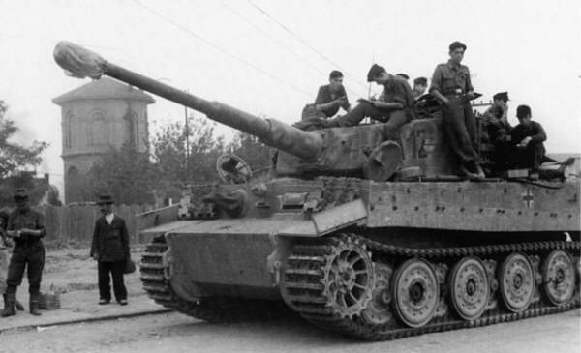 Mid-production Tiger I’s have the second design turret with the smaller cupola but retain the rubber-rimmed roadwheels.
Mid-production Tiger I’s have the second design turret with the smaller cupola but retain the rubber-rimmed roadwheels.
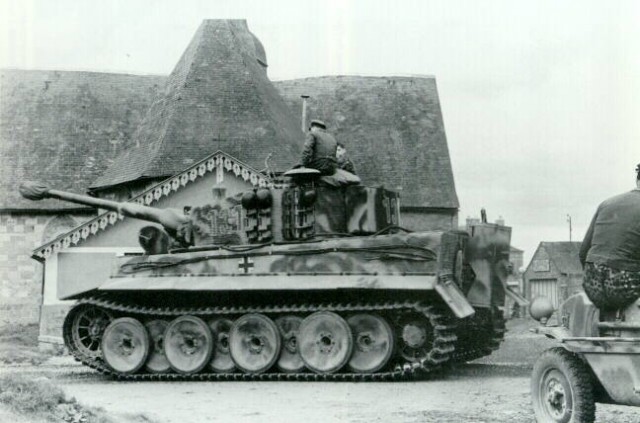
Camo Tiger showing the new cupola with side-swinging hatch. It still has the early model
roadwheels. The lack of Feifel filters would date this vehicle at December ’43 or later.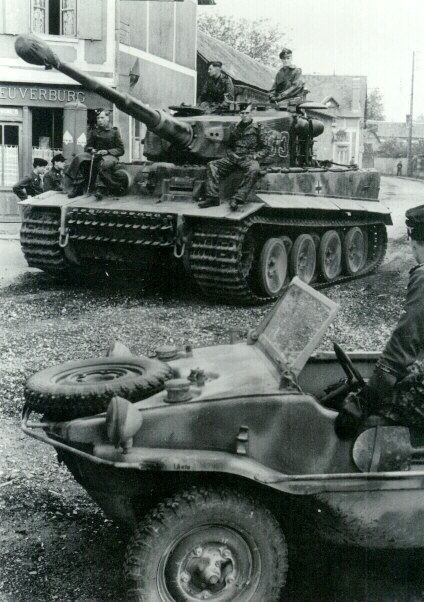
Another camoflaged mid-production example with muzzlebrake
and MG covers in place.
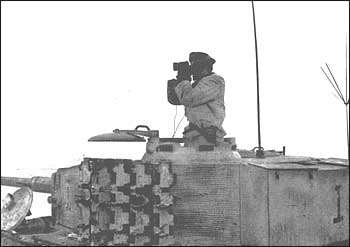
Good view of the revised commanders cupola.
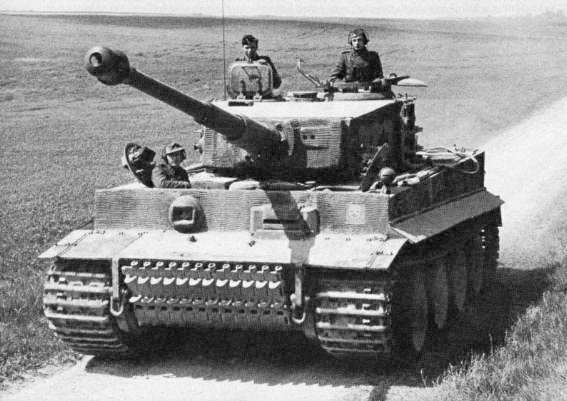
This is an interesting study. It has dual headlights which were phased out in late
August ’43. However it is covered in Zimmerit anti-magnetic paste which was
introduced in early August of ’43, most likely making this a mid-August production tank.
 Mid-production Tiger I’s have the second design turret with the smaller cupola but retain the rubber-rimmed roadwheels.
Mid-production Tiger I’s have the second design turret with the smaller cupola but retain the rubber-rimmed roadwheels.
Camo Tiger showing the new cupola with side-swinging hatch. It still has the early model
roadwheels. The lack of Feifel filters would date this vehicle at December ’43 or later.

Another camoflaged mid-production example with muzzlebrake
and MG covers in place.

Good view of the revised commanders cupola.

This is an interesting study. It has dual headlights which were phased out in late
August ’43. However it is covered in Zimmerit anti-magnetic paste which was
introduced in early August of ’43, most likely making this a mid-August production tank.
TIGER, TIGER – BURNING BRIGHT – By Mark Barnes
May 6, 2015
 You cannot fail to be impressed by the brutal appearance of this iconic tank.
You cannot fail to be impressed by the brutal appearance of this iconic tank.
The Tiger did a couple of laps before eventually heading off for a mini road run around the museum site. By this time Jack and I were both distinctly under the weather from bouts of manflu – an unwanted coincidence seeing as I haven’t seen the bugger since February. I picked mine up larking about on the rifle range at Bisley and you will read about that soon enough.
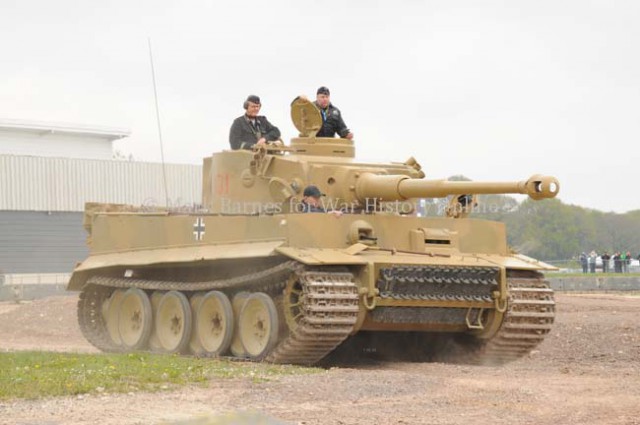 The Tiger did a few laps before heading off on a mini road run around the museum site to a chorus of approval from the large crowd.
The Tiger did a few laps before heading off on a mini road run around the museum site to a chorus of approval from the large crowd.
The Kettenkrad and the two post war tanks were all good value for money. You can’t go wrong with a Centurion, but for sheer power the Leopard is hard to beat.
It was throwing up dust like nobody’s business and I don’t doubt the effect of having three classic German tanks on show was appreciated by such a knowledgeable public.
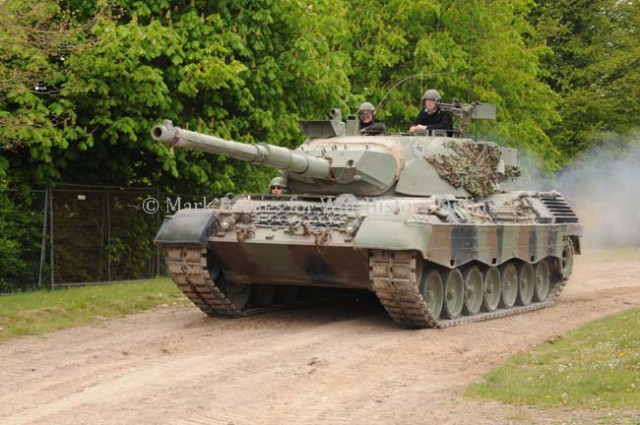 Post war delights were provided by a Centurion and this Canadian Leopard which put on a great show for the crowd.
Post war delights were provided by a Centurion and this Canadian Leopard which put on a great show for the crowd.
Honestly, I am genuinely stunned by the huge interest in the Tiger. I can understand it because I am hooked anyway, but it must be a great feeling knowing a day like this had drawn in so many members of the paying public and things bode well for Tankfest and other events Bovvy have planned.
Jack and I held our post mortem in a busy pub in Weymouth harbour where wall-to-wall tellies showed a succession of inane junk distracting us from our supper. It reminded us why we have opted to do things a bit differently. There will always be more to life than tanks, but they do add something other diversions have no hope of matching.
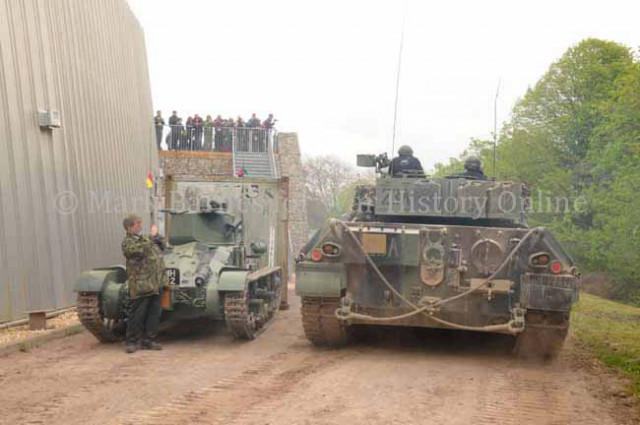 Comparing the Matilda and the Leopard is clearly a waste of effort! However they illustrate the range of armoured vehicles on display at the Tank Museum.
Comparing the Matilda and the Leopard is clearly a waste of effort! However they illustrate the range of armoured vehicles on display at the Tank Museum.
I know sod all about budgets and demographics, but it seems obvious to me that Tiger Day was a big success for the Tank Museum. The place was filled with people of all ages – not just the usual suspects. I met up with a friend who made the tortuous journey from our corner of the country for the occasion and he was very impressed.
To be fair he liked everything the museum had to offer, but the Tiger really did burn bright like Blake’s poem says and I am looking forward to Tankfest in June where there should be much to report. War History Online will be at the event in force, so say hello if you see us.
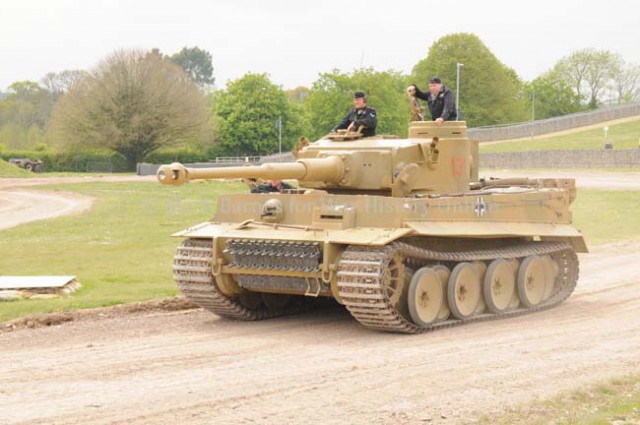 Tiger 131. We plan to see it again at Tankfest at the end of June.
Tiger 131. We plan to see it again at Tankfest at the end of June.
With thanks to Roz Skellorn and everyone at the Tank Museum, Bovington.
Find out about Tankfest at www.tankmuseum.org/whatson/events/bovevt37899
Do visit the Tank Museum, Bovington and there are many ways you can support them see here for more detailswww.TankMuseum.org
May 6, 2015
 You cannot fail to be impressed by the brutal appearance of this iconic tank.
You cannot fail to be impressed by the brutal appearance of this iconic tank.The Tiger did a couple of laps before eventually heading off for a mini road run around the museum site. By this time Jack and I were both distinctly under the weather from bouts of manflu – an unwanted coincidence seeing as I haven’t seen the bugger since February. I picked mine up larking about on the rifle range at Bisley and you will read about that soon enough.
 The Tiger did a few laps before heading off on a mini road run around the museum site to a chorus of approval from the large crowd.
The Tiger did a few laps before heading off on a mini road run around the museum site to a chorus of approval from the large crowd.The Kettenkrad and the two post war tanks were all good value for money. You can’t go wrong with a Centurion, but for sheer power the Leopard is hard to beat.
It was throwing up dust like nobody’s business and I don’t doubt the effect of having three classic German tanks on show was appreciated by such a knowledgeable public.
 Post war delights were provided by a Centurion and this Canadian Leopard which put on a great show for the crowd.
Post war delights were provided by a Centurion and this Canadian Leopard which put on a great show for the crowd. Honestly, I am genuinely stunned by the huge interest in the Tiger. I can understand it because I am hooked anyway, but it must be a great feeling knowing a day like this had drawn in so many members of the paying public and things bode well for Tankfest and other events Bovvy have planned.
Jack and I held our post mortem in a busy pub in Weymouth harbour where wall-to-wall tellies showed a succession of inane junk distracting us from our supper. It reminded us why we have opted to do things a bit differently. There will always be more to life than tanks, but they do add something other diversions have no hope of matching.
 Comparing the Matilda and the Leopard is clearly a waste of effort! However they illustrate the range of armoured vehicles on display at the Tank Museum.
Comparing the Matilda and the Leopard is clearly a waste of effort! However they illustrate the range of armoured vehicles on display at the Tank Museum.I know sod all about budgets and demographics, but it seems obvious to me that Tiger Day was a big success for the Tank Museum. The place was filled with people of all ages – not just the usual suspects. I met up with a friend who made the tortuous journey from our corner of the country for the occasion and he was very impressed.
To be fair he liked everything the museum had to offer, but the Tiger really did burn bright like Blake’s poem says and I am looking forward to Tankfest in June where there should be much to report. War History Online will be at the event in force, so say hello if you see us.
 Tiger 131. We plan to see it again at Tankfest at the end of June.
Tiger 131. We plan to see it again at Tankfest at the end of June.With thanks to Roz Skellorn and everyone at the Tank Museum, Bovington.
Find out about Tankfest at www.tankmuseum.org/whatson/events/bovevt37899
Do visit the Tank Museum, Bovington and there are many ways you can support them see here for more detailswww.TankMuseum.org
The WHO team attended Tiger Day at the Tank Museum, Bovington, where the film stars of Fury! the unique running Tiger 131 and the classic ‘Easy 8’ Sherman put on a great show for a large crowd. Words and pictures by Mark Barnes
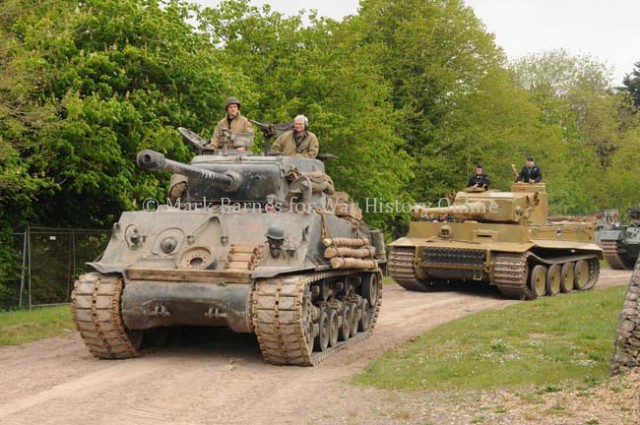
The unseasonably cold and inclement weather we had for much of the May Bank Holiday weekend in England may well define the memory of it in the hearts of the people streaming west when I drove down to Dorset from London last Friday. It took me five hours to get to Dorchester from the capital; such was the weight of traffic.
Cold and miserable it may have been, but the warmth of the welcome and the sheer number of people rocking up at the Tank Museum told my colleague Jack Beckett and I that we were in for a busy and interesting day. We were not disappointed.
The wise decision to hold Tiger Day is boosted, without doubt, by the impact of Fury! This is a movie you can either love or hate for all your own reasons. I’ve seen it a few times, now, and there are parts I think are outstanding while others are a little too Hollywood on reflection. It doesn’t matter what I think, the crowd at Bovington made it clear where their affections lay.
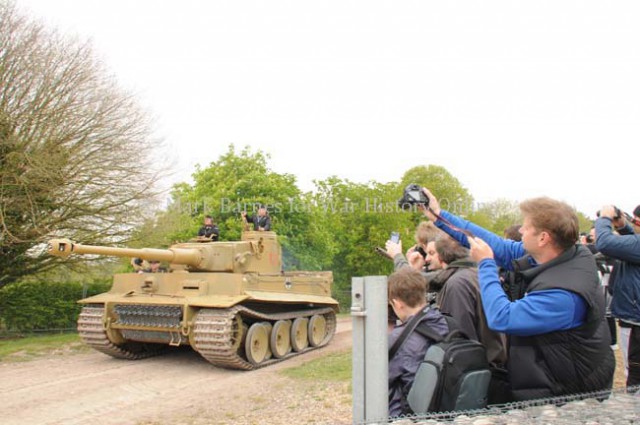 The amount of video and still photography devoted to the Tiger was enormous.
The amount of video and still photography devoted to the Tiger was enormous.
While the museum presented an open day with wide ranging displays and talks, it was a running Tiger that people had come to see and I have to say I have never witnessed such a buzz of anticipation for a tank. Think about that – a tank. We live in a heavily populated country of tens of millions and this was a weekend when a lot of other stuff was going on in England and the rest of the UK.
Quite separate from the world of us mere mortals we had a new royal baby, Chelsea won the Premier League and the General Election campaign was at full chat ahead of Thursday’s vote. Roll on Thursday! Cheerfully ignoring the headline dominating stuff all these people had come to see a tank. Well, that isn’t quite true – they also got to see Fury itself, the Sherman looked and sounded great following an engine replacement after all that arduous film work.
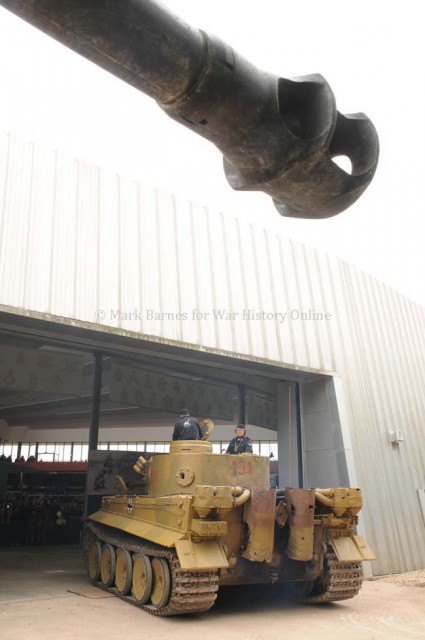 The Tiger emerges from the museum under the gun of ‘Fury’.
The Tiger emerges from the museum under the gun of ‘Fury’.
Before the Tiger got going I had a quick chat with the ever smiling museum director Richard Smith and he told me he and his colleagues had learned a lot from the tank’s moment in the movie spotlight and wouldn’t rule out doing something similar again. But he was more interested to give me some idea of how the museum would deal with a fire, following on from the tragic loss of the Surrey Infantry Museum at Clandon House, and it emphasises just how important our museums are to the people who run them.
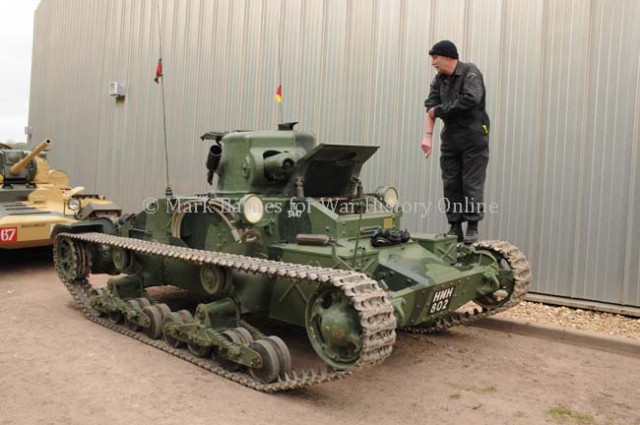 The museum has three examples of the Matilda Mk1. Unfortunately this one refused to start despite every effort.
The museum has three examples of the Matilda Mk1. Unfortunately this one refused to start despite every effort.
Just to keep us keyed up, the museum ran a number of other exhibits – a Valentine, T-34, Panzer III, a zippy Kettenkrad, a beautiful Centurion and a truly stunning Canadian army Leopard. Unfortunately the diminutive Mk1 Matilda failed to start. I was busy for the Tiger to start up so I missed the Valentine’s laps altogether and only caught the end of the T-34.
for the Tiger to start up so I missed the Valentine’s laps altogether and only caught the end of the T-34.
I have to say I was really pleased to see the Panzer III on the go. For whatever reason I have always conspired to miss Tankfest where the PzIII has run on several occasions, so this was a first for me and I am pleased to have seen it at long last.
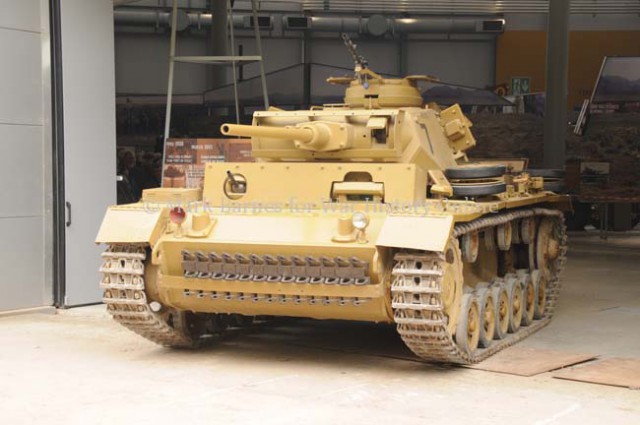 The Panzer III emerges from the museum building.
The Panzer III emerges from the museum building.
Fury went next and really kicked up the dust. The first of the film star duo doing a turn, it was well received by an enthusiastic crowd and I have to say it is a very impressive piece of kit. I’ve had my moments with Shermans, I am still suffering from a bone snapping encounter last summer, but it is always good to see them hammering along. How long this one will stay in its movie guise is anyone’s guess, but a procession of people wanted to be photographed with it.
The big old Easy 8 is a genuine movie star if ever there was one. Many were talking about it being in their favourite film and the impact of this should not be underestimated. It remains to be seen whether it will have anything like the impetus SPR and B of B injected into the World War II history scene but while crowds like these turn out things can only be good for the Tank Museum.
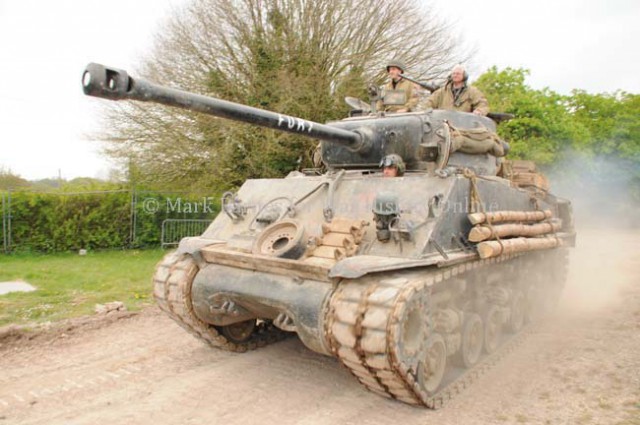 The Sherman looks like it rumbled straight out of the movie screen, kicking up a fair amount of arena dust and sounding beautiful.
The Sherman looks like it rumbled straight out of the movie screen, kicking up a fair amount of arena dust and sounding beautiful.
But it was the Tiger that everyone had come to see. I’m a Panther man myself, but I felt like I had witnessed something genuinely special watching 131 wow the crowd. A number of people had paid a significant sum of money to be able to climb up on it and learn a bit about the tank and you could see that the experience meant a lot to them. The sheer number of still photos and bits of video the public shot must be swamping the tankie corner of Facebook and YouTube today.
I picked a spot where I could watch 131 reverse out of the museum building and rumble up behind the Sherman. A local radio reporter standing with me was in awe. He told me Fury! is his favourite movie and he could not believe he would be able to watch the very same tanks rumble by. I suppose he illustrates perfectly the impact living history can have. The Tiger was a lot quieter than I expected and quite squeaky in that clankety-clank way we want from old tanks, but like any cat it just purred contentedly.

The unseasonably cold and inclement weather we had for much of the May Bank Holiday weekend in England may well define the memory of it in the hearts of the people streaming west when I drove down to Dorset from London last Friday. It took me five hours to get to Dorchester from the capital; such was the weight of traffic.
Cold and miserable it may have been, but the warmth of the welcome and the sheer number of people rocking up at the Tank Museum told my colleague Jack Beckett and I that we were in for a busy and interesting day. We were not disappointed.
The wise decision to hold Tiger Day is boosted, without doubt, by the impact of Fury! This is a movie you can either love or hate for all your own reasons. I’ve seen it a few times, now, and there are parts I think are outstanding while others are a little too Hollywood on reflection. It doesn’t matter what I think, the crowd at Bovington made it clear where their affections lay.
 The amount of video and still photography devoted to the Tiger was enormous.
The amount of video and still photography devoted to the Tiger was enormous.While the museum presented an open day with wide ranging displays and talks, it was a running Tiger that people had come to see and I have to say I have never witnessed such a buzz of anticipation for a tank. Think about that – a tank. We live in a heavily populated country of tens of millions and this was a weekend when a lot of other stuff was going on in England and the rest of the UK.
Quite separate from the world of us mere mortals we had a new royal baby, Chelsea won the Premier League and the General Election campaign was at full chat ahead of Thursday’s vote. Roll on Thursday! Cheerfully ignoring the headline dominating stuff all these people had come to see a tank. Well, that isn’t quite true – they also got to see Fury itself, the Sherman looked and sounded great following an engine replacement after all that arduous film work.
 The Tiger emerges from the museum under the gun of ‘Fury’.
The Tiger emerges from the museum under the gun of ‘Fury’.Before the Tiger got going I had a quick chat with the ever smiling museum director Richard Smith and he told me he and his colleagues had learned a lot from the tank’s moment in the movie spotlight and wouldn’t rule out doing something similar again. But he was more interested to give me some idea of how the museum would deal with a fire, following on from the tragic loss of the Surrey Infantry Museum at Clandon House, and it emphasises just how important our museums are to the people who run them.
 The museum has three examples of the Matilda Mk1. Unfortunately this one refused to start despite every effort.
The museum has three examples of the Matilda Mk1. Unfortunately this one refused to start despite every effort.Just to keep us keyed up, the museum ran a number of other exhibits – a Valentine, T-34, Panzer III, a zippy Kettenkrad, a beautiful Centurion and a truly stunning Canadian army Leopard. Unfortunately the diminutive Mk1 Matilda failed to start. I was busy
 for the Tiger to start up so I missed the Valentine’s laps altogether and only caught the end of the T-34.
for the Tiger to start up so I missed the Valentine’s laps altogether and only caught the end of the T-34.I have to say I was really pleased to see the Panzer III on the go. For whatever reason I have always conspired to miss Tankfest where the PzIII has run on several occasions, so this was a first for me and I am pleased to have seen it at long last.
 The Panzer III emerges from the museum building.
The Panzer III emerges from the museum building.Fury went next and really kicked up the dust. The first of the film star duo doing a turn, it was well received by an enthusiastic crowd and I have to say it is a very impressive piece of kit. I’ve had my moments with Shermans, I am still suffering from a bone snapping encounter last summer, but it is always good to see them hammering along. How long this one will stay in its movie guise is anyone’s guess, but a procession of people wanted to be photographed with it.
The big old Easy 8 is a genuine movie star if ever there was one. Many were talking about it being in their favourite film and the impact of this should not be underestimated. It remains to be seen whether it will have anything like the impetus SPR and B of B injected into the World War II history scene but while crowds like these turn out things can only be good for the Tank Museum.
 The Sherman looks like it rumbled straight out of the movie screen, kicking up a fair amount of arena dust and sounding beautiful.
The Sherman looks like it rumbled straight out of the movie screen, kicking up a fair amount of arena dust and sounding beautiful.But it was the Tiger that everyone had come to see. I’m a Panther man myself, but I felt like I had witnessed something genuinely special watching 131 wow the crowd. A number of people had paid a significant sum of money to be able to climb up on it and learn a bit about the tank and you could see that the experience meant a lot to them. The sheer number of still photos and bits of video the public shot must be swamping the tankie corner of Facebook and YouTube today.
I picked a spot where I could watch 131 reverse out of the museum building and rumble up behind the Sherman. A local radio reporter standing with me was in awe. He told me Fury! is his favourite movie and he could not believe he would be able to watch the very same tanks rumble by. I suppose he illustrates perfectly the impact living history can have. The Tiger was a lot quieter than I expected and quite squeaky in that clankety-clank way we want from old tanks, but like any cat it just purred contentedly.
Tanks at Balaton – Brittle German Armour
I’ve explored the issue of brittle German armour in many articles, but each one seems to get the same complaint: it’s only an experiment, real life is not like this! Here are some photos from the battle at Lake Balaton (Operation Spring Awakening) that demonstrate very well how far German armour declined.
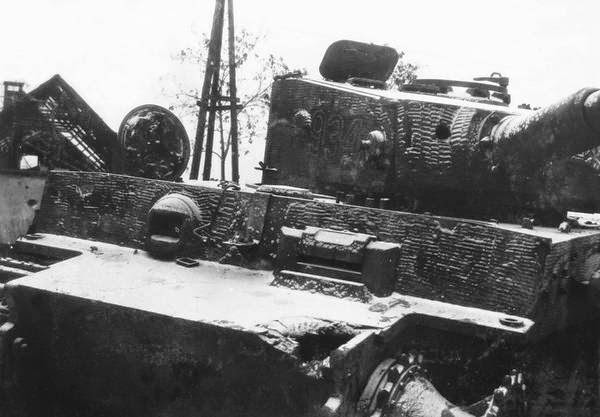 Despite hitting the Tiger’s highly sloped transmission cover, this shell made a large breach in the tank’s armour, destroying it.
Despite hitting the Tiger’s highly sloped transmission cover, this shell made a large breach in the tank’s armour, destroying it.
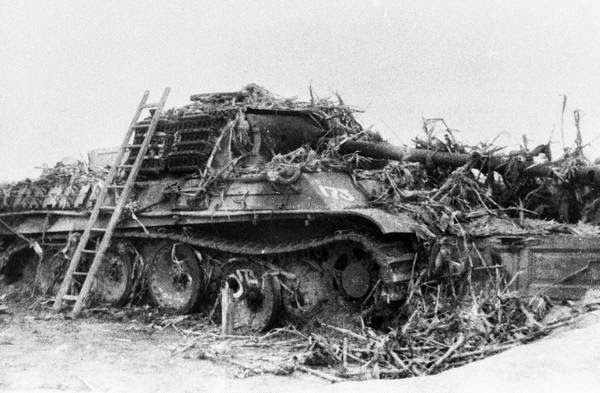 Some people tell me that the Panther’s wheels protected its thin side armour from low caliber guns, but that does not seem to be the case here. This Panther was hit through the wheel and then the side armour, knocking it out.
Some people tell me that the Panther’s wheels protected its thin side armour from low caliber guns, but that does not seem to be the case here. This Panther was hit through the wheel and then the side armour, knocking it out.
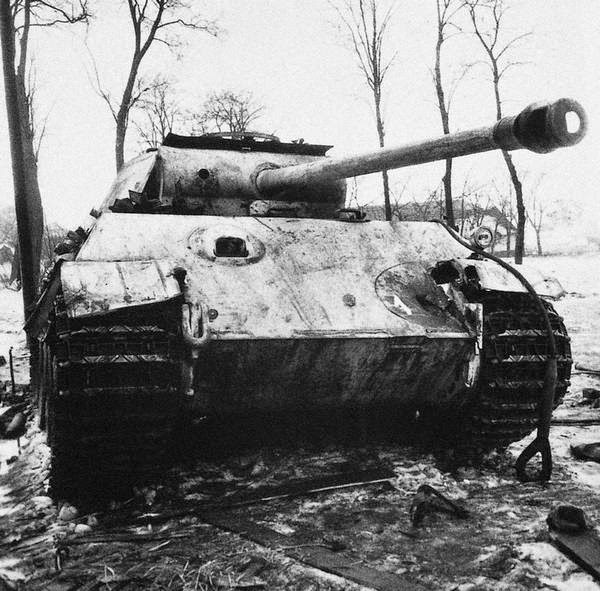 This Panther fell victim to a high caliber HE shell. The shell ricocheted off its upper front plate, but left a breach and cracks in the armour. The tank was abandoned by its crew.
This Panther fell victim to a high caliber HE shell. The shell ricocheted off its upper front plate, but left a breach and cracks in the armour. The tank was abandoned by its crew.
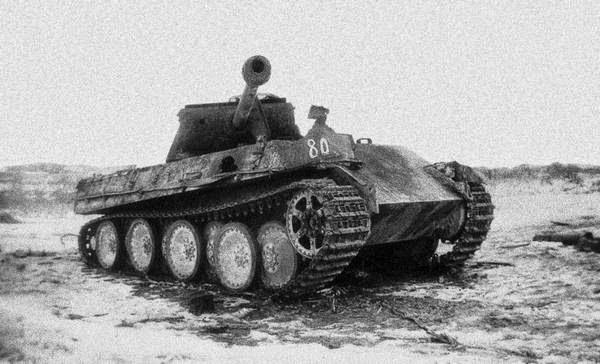 A relatively routine penetration of the Panther’s side armour, leading to significant amount of spalling.
A relatively routine penetration of the Panther’s side armour, leading to significant amount of spalling.
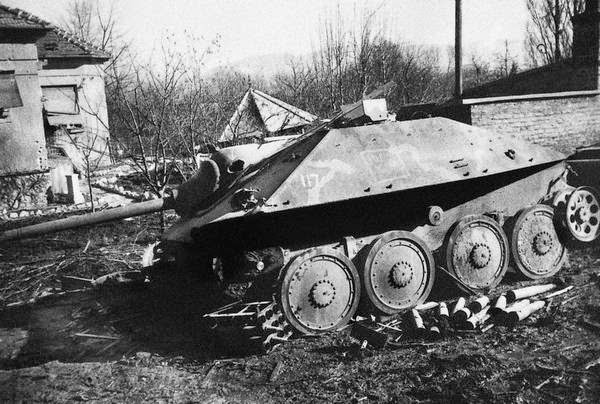 This Jadgpanzer 38(t) fell victim to a 76 mm round, despite its highly angled 60 mm of armour around the gun mantlet. Interestingly enough, the armour was not as brittle here as it was on the Panther above.
This Jadgpanzer 38(t) fell victim to a 76 mm round, despite its highly angled 60 mm of armour around the gun mantlet. Interestingly enough, the armour was not as brittle here as it was on the Panther above.
[iframe style="border: 0px currentColor; vertical-align: bottom; max-width: 100%;" id="google_ads_iframe_/6766078/WHOL_300x250_inline_0" height="280" marginHeight="0" src="javascript:"[/iframe]
 A gaping hole in the side of a Wirbelwind.
A gaping hole in the side of a Wirbelwind.
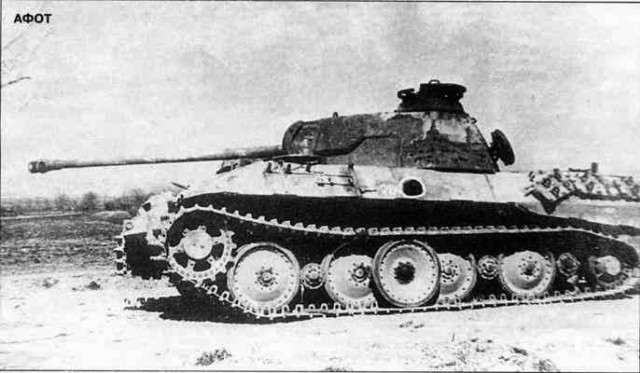 Another Panther with a huge hole in its side.
Another Panther with a huge hole in its side.
Read more on Archive Awareness
I’ve explored the issue of brittle German armour in many articles, but each one seems to get the same complaint: it’s only an experiment, real life is not like this! Here are some photos from the battle at Lake Balaton (Operation Spring Awakening) that demonstrate very well how far German armour declined.
 Despite hitting the Tiger’s highly sloped transmission cover, this shell made a large breach in the tank’s armour, destroying it.
Despite hitting the Tiger’s highly sloped transmission cover, this shell made a large breach in the tank’s armour, destroying it. Some people tell me that the Panther’s wheels protected its thin side armour from low caliber guns, but that does not seem to be the case here. This Panther was hit through the wheel and then the side armour, knocking it out.
Some people tell me that the Panther’s wheels protected its thin side armour from low caliber guns, but that does not seem to be the case here. This Panther was hit through the wheel and then the side armour, knocking it out. This Panther fell victim to a high caliber HE shell. The shell ricocheted off its upper front plate, but left a breach and cracks in the armour. The tank was abandoned by its crew.
This Panther fell victim to a high caliber HE shell. The shell ricocheted off its upper front plate, but left a breach and cracks in the armour. The tank was abandoned by its crew. A relatively routine penetration of the Panther’s side armour, leading to significant amount of spalling.
A relatively routine penetration of the Panther’s side armour, leading to significant amount of spalling. This Jadgpanzer 38(t) fell victim to a 76 mm round, despite its highly angled 60 mm of armour around the gun mantlet. Interestingly enough, the armour was not as brittle here as it was on the Panther above.
This Jadgpanzer 38(t) fell victim to a 76 mm round, despite its highly angled 60 mm of armour around the gun mantlet. Interestingly enough, the armour was not as brittle here as it was on the Panther above.[iframe style="border: 0px currentColor; vertical-align: bottom; max-width: 100%;" id="google_ads_iframe_/6766078/WHOL_300x250_inline_0" height="280" marginHeight="0" src="javascript:"[/iframe]
 A gaping hole in the side of a Wirbelwind.
A gaping hole in the side of a Wirbelwind. Another Panther with a huge hole in its side.
Another Panther with a huge hole in its side.Read more on Archive Awareness
Tanques Tiger, vuelta a la dura realidad
Cuando apareció el tanque Tiger, su coraza resultó ser insultantemente superior a cualquier arma desplegada por los aliados. Cuando los soviéticos capturaron un ejemplar e hicieron pruebas balísticas, se alarmaron. El cañón de 76.2mm (instalado en el KV-1, T-34 y utilizado como artillería) era casi inútil. Tan sólo podía penetrar la coraza lateral y trasera desde 200 metros. Teniendo en cuenta la ventaja del cañón de 88mm, capaz de destruir los KV-1/T-34 desde +1.000 metros, el problema era preocupante.
Entre 1943 y principios de 1944 los Tiger no tuvieron competidores. Los angloamericanos siguieron utilizando el Sherman con el cañón de 75mm y modelos británicos armados con un cañón de 6lb. En el este los soviéticos siguieron utilizando el T-34-76. Tan sólo el SU-152 era peligroso desde largas distancias, pero normalmente operaba con la infantería y frente a posiciones fortificadas.....
Nota Completa: http://alejandro-8.blogspot.com.es/2012/10/tanques-tiger-vuelta-la-dura-realidad.html
Cuando apareció el tanque Tiger, su coraza resultó ser insultantemente superior a cualquier arma desplegada por los aliados. Cuando los soviéticos capturaron un ejemplar e hicieron pruebas balísticas, se alarmaron. El cañón de 76.2mm (instalado en el KV-1, T-34 y utilizado como artillería) era casi inútil. Tan sólo podía penetrar la coraza lateral y trasera desde 200 metros. Teniendo en cuenta la ventaja del cañón de 88mm, capaz de destruir los KV-1/T-34 desde +1.000 metros, el problema era preocupante.
Entre 1943 y principios de 1944 los Tiger no tuvieron competidores. Los angloamericanos siguieron utilizando el Sherman con el cañón de 75mm y modelos británicos armados con un cañón de 6lb. En el este los soviéticos siguieron utilizando el T-34-76. Tan sólo el SU-152 era peligroso desde largas distancias, pero normalmente operaba con la infantería y frente a posiciones fortificadas.....
Nota Completa: http://alejandro-8.blogspot.com.es/2012/10/tanques-tiger-vuelta-la-dura-realidad.html

Many people complain that shooting at one tank during tests several times is unfair, but this is what a Panther caught in a Soviet ambush looks like. Several shots to the side resulted in a large portion of the armour caving in.
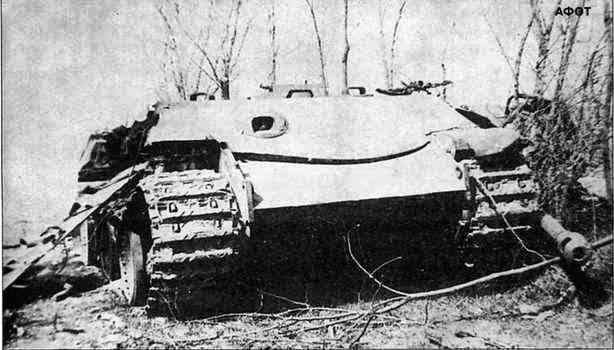
An explosion split this Panther's upper front plate all the way across.

This is a very interesting shot, as it managed to penetrate the gun, and then the gun mantlet behind it.

Another set of lucky shots to the turret that managed to knock off the gun.

Another Panther with an enormous crack across its front armour.

Another Panther that was caught in an ambush. Three shots to the turret seemed to not crack the armour that much, but the lower turret and upper hull shots resulted in a lot of spalling.

More effective shots to the turret. These one did not knock the gun off, but knocked out the tank anyway.

One or two shots to the side of the turret resulted in a huge breach forming.

Another Panther that was likely the victim of an ambush, and another one where the turret fares a lot better in terms of spalling then the hull.
Este es un Panzer IV... Panzerkampfwagen IV para los puristas (o PzKpfw IV)

Tanks at Balaton – Brittle German Armour
I’ve explored the issue of brittle German armour in many articles, but each one seems to get the same complaint: it’s only an experiment, real life is not like this! Here are some photos from the battle at Lake Balaton (Operation Spring Awakening) that demonstrate very well how far German armour declined.
Despite hitting the Tiger’s highly sloped transmission cover, this shell made a large breach in the tank’s armour, destroying it.
Some people tell me that the Panther’s wheels protected its thin side armour from low caliber guns, but that does not seem to be the case here. This Panther was hit through the wheel and then the side armour, knocking it out.
This Panther fell victim to a high caliber HE shell. The shell ricocheted off its upper front plate, but left a breach and cracks in the armour. The tank was abandoned by its crew.
A relatively routine penetration of the Panther’s side armour, leading to significant amount of spalling.
This Jadgpanzer 38(t) fell victim to a 76 mm round, despite its highly angled 60 mm of armour around the gun mantlet. Interestingly enough, the armour was not as brittle here as it was on the Panther above.
[iframe style="border: 0px currentColor; vertical-align: bottom; max-width: 100%;" id="google_ads_iframe_/6766078/WHOL_300x250_inline_0" height="280" marginHeight="0" src="javascript:"[/iframe]
A gaping hole in the side of a Wirbelwind.
Another Panther with a huge hole in its side.
Read more on Archive Awareness
Salvo el primero que un Tigre, el resto son todos Panther y un Flakpanzer IV...
Many people complain that shooting at one tank during tests several times is unfair, but this is what a Panther caught in a Soviet ambush looks like. Several shots to the side resulted in a large portion of the armour caving in.

An explosion split this Panther's upper front plate all the way across.

This is a very interesting shot, as it managed to penetrate the gun, and then the gun mantlet behind it.

Another set of lucky shots to the turret that managed to knock off the gun.

Another Panther with an enormous crack across its front armour.

Another Panther that was caught in an ambush. Three shots to the turret seemed to not crack the armour that much, but the lower turret and upper hull shots resulted in a lot of spalling.

More effective shots to the turret. These one did not knock the gun off, but knocked out the tank anyway.

One or two shots to the side of the turret resulted in a huge breach forming.

Another Panther that was likely the victim of an ambush, and another one where the turret fares a lot better in terms of spalling then the hull.
Temas similares
- Respuestas
- 0
- Visitas
- 863
- Respuestas
- 1
- Visitas
- 1K


